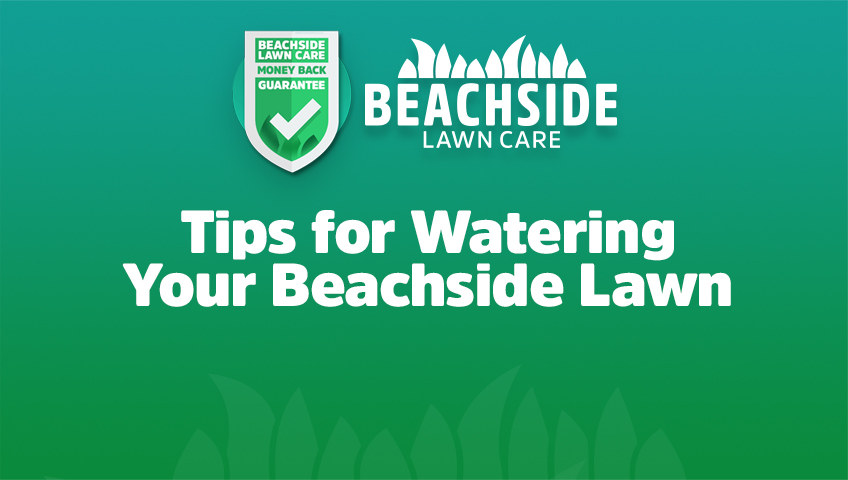Are you tired of brown patches in your front lawn, side yard or backyard? Or have areas in the lawn where the grass is crunchy & even dead? There is never a time like the present to be proactive and do something about it. This article will hint on some tips for when to water your lawn, how minor adjustments to sprinkler systems can help, and possibly some lawn-saving information.
Beachside Lawn Care Watering 101
Many ask, What time of the day should I water my lawn?
It’s best to water during the cool, early morning hours of the day. Evaporation loss can be 50% (fifty percent) higher during the middle of the day. By watering when the grass is already wet from the highest dew point, you won’t alter the natural moisture state of the lawn. If you must water in the late afternoon, try and stop watering with enough time before dark to allow the grass to completely dry. Watering close to night fall is not recommended due to the moisture promoting fungus and diseases. From Beachside Lawn Care, a good rule of thumb is to water early morning so your last zone is completing around the time the sun is rising, this will allow the grass to soak up the water, and completely dry without too much evaporation.
How long should I water my lawn?
For most Florida soils, an average of one half to three forth’s of an inch of water per irrigation run time is enough to replenish the levels necessary for growth. It’s best to saturate the roots and then let the soil dry completely for promoting deep root growth. You may find during hot, dry months, a full inch is recommended but you should always follow your local cities local water regulations. They may have restrictions on days, times, and frequencies for watering your lawn.
– Melbourne Irrigation Schedule
– Cocoa Beach Irrigation Schedule
– Palm Bay Irrigation Schedule
– Suntree & Viera Irrigation Schedule
– Saint Johns River Water Management District
To determine how long to run your sprinklers, you can place multiple empty and straight-sided containers or cups at several locations within each zone. Using uniform containers work best, for example coffee mugs, or similar cups. Run the irrigation system for a minimum of 15 minutes and measure the amount of water collected in each container. Once you have gathered all of your zones, calculate an average water depth and determine how long it will take to cover your lawn with the required water amount.
How should I water my Floratam, St. Augustine grass during the different seasons?
Lets take a look at both Floratam and St. Augustine Grass types.
Saint Augustine: Saint Augustine grass is a warm-season grass that is hardy in U.S. Department of Agriculture plant hardiness zones 8 through 10. This broad-bladed, medium-green turf grass thrives in sunny locations, but unlike some sun-loving grasses, it also has a high shade tolerance. Common St. Augustine grass grows quickly during summer, but more slowly in fall and spring. It is a salt- and drought-tolerant grass that requires moderate maintenance.
Floratam: Like most Saint Augustine grasses, Floratam is coarse-textured grass, but a distinguishing feature of Floratam is its longer and wider leaf blades. This dark-green cultivar grows rapidly in both spring and summer. It is less cold and shade tolerant than other St. Augustine grass cultivars and can suffer from freeze damage when temperatures stay below freezing for an extended period of time; it is hardy only in USDA zones 9 and 10. Floratam needs plenty of sunshine and will perform poorly if it receives less than six hours of sunlight a day.
Watering March through Early June
This is the most important time of the year to be diligent with watering your lawn. If the watering restrictions in your area allow for twice per week, and your applying the recommended amount each cycle, then your lawn will do just fine. However, if your only permitted to water once per week, then you should expect to see some browning or damage in some parts of the lawn. If you have Floratam grass, watering on a 7 day interval without natural rain will stress the grass. This can cause major damage over the hot and sunny months.
Watering June through September
Watering twice per week is necessary throughout the primary summer months. If you find that you experience a short period with zero rain you must irrigate to avoid damaging your lawn. If you experience heavy amounts of rain, you may be able to turn your system off for a week or two, due to the amount of rain fall.
Watering October through February
During this period your St. Augustine & Floratam will need less frequent watering due to the daytime temperatures averaging in the 70’s and 80’s. If you experience daytime temperatures in the 60’s and 70’s you can do without any additional watering. The best rule of thumb is to keep your regular schedule year around. Unless your city/ county regulations specify specific watering days/times stay on track.
Should I Adjust my Sprinkler Heads?
If you find yourself noticing irregular growth patterns, or browning only occurring in specific areas. You may need to adjust your sprinkler heads to ensure that area is watered during the irrigation zone. Here is a video that may help you understand more about sprinkler coverage.
If you are having issue with keeping your lawn looking it’s best, please click here to contact us for a free estimate!

